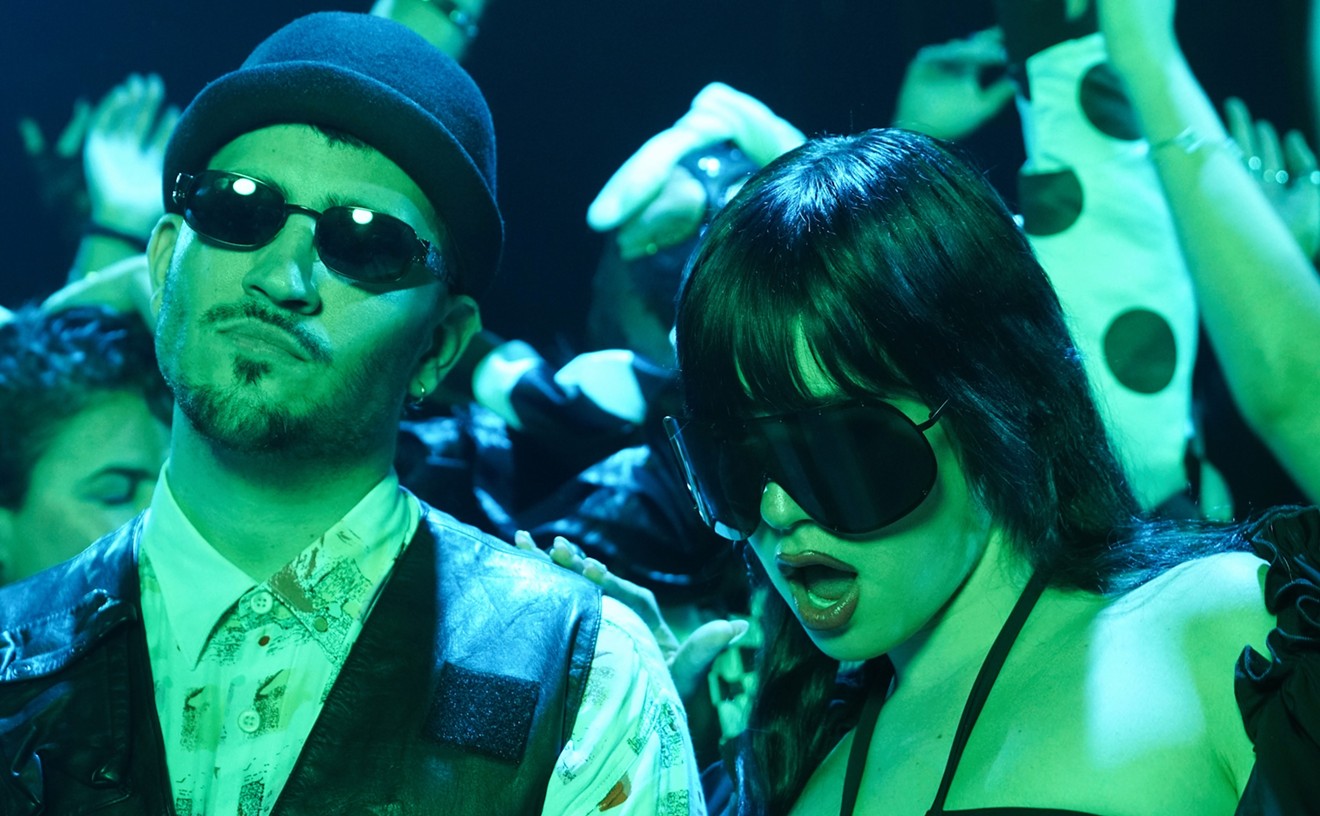Others might not have been quite so happy -- and not only those Cuban exiles who regard the island's musicians as "agents of Castro." Yes, a Grammy-winning album of Cuban music constituted something of an upset, but given that music's current cachet, it was not a total surprise. What was perhaps more of a jolt to the Latin music industry was that their award was usurped by "outsiders."
After all, the Tropical category is one of the few Grammy spots open to Latin music. Miami-based mambo pioneer Israel "Cachao" López took home the prize in 1994, but generally the term "tropical" is synonymous with contemporary salsa -- lovesick, commercial Latin dance music. The nominees for Best Tropical Latin Performance included the large-lunged Nuyorican vocalist India (on salsa impresario Ralph Mercado's RMM label) and Albita (on the Sony imprint Crescent Moon, headed by Grammy-friendly Emilio Estefan -- two-time winner Gloria Estefan was one of this year's presenters). No male soloists made the list, noteworthy given Latin music's traditionally macho bent.
There is no question that Buena Vista deserves praise: It is a gorgeous, passionate album, a consummate example of classic Cuban son, a collaborative effort resulting in simply perfect music. (Cooder is currently back in Havana working on another album, this one featuring septuagenarian singer Ibrahim Ferrer.) But whether Buena Vista Social Club should have been included in the Tropical Latin category at all is debatable. As an album of folkloric standards, it could easily have been placed in the world music division (won by Brazil's Milton Nascimento). Buena Vista was released by a world music label, the United Kingdom-based World Circuit, and distributed in the United States by Nonesuch. (Another World Circuit/Nonesuch release, the Afro-Cuban All-Stars' A Toda Cuba Le Gusta, was also nominated in the Tropical category.) Furthermore, Buena Vista Social Club was produced not by a money-smart Latin insider, but by an American musician-cum-musicologist. And the CD features a band of old-timers whose craggy faces and baggy clothes fit the world music image of folkloric chic.
Granted, the Grammy Awards are voted on by members of an American entity, the National Academy of Recording Arts and Sciences, many of whom don't know mierda about Spanish-language music. At best the Grammys reflect the Latin music tastes of the Anglo or "crossover" market. They're not Los Nuestros (Ours), as the annual Univisión music awards are called, but rather "theirs."
"Sometimes we win, sometimes we lose," comments Emilio Estefan, who figures that the non-Latin voters were drawn by the novelty of the traditional Cuban sound. "With the Grammys you have 13,000 different people voting. You never know what they're going to go for."
But just because the Grammys honored Buena Vista Social Club doesn't mean you will ever hear it on local Spanish-language radio. "We have no plans to play any music by Cuban bands," confirms Keith Isley, program director at La Nueva 98 (WRTO-FM 98.3), from which sponsors threatened to pull out last year when the station added music by several Cuban dance groups to its playlist.
To date, Buena Vista has sold more than 150,000 copies in the United States, and the album is currently number one on Billboard's Latin Top 50 chart. Through a highly visible -- and inclusive -- marketing campaign, World Circuit has reached a much broader audience than is normally tapped by the Latin labels, which typically ignore the Anglo market in favor of interests in Latin America. As a result, a lot of non-Latins have discovered something "new." For established Latin music fans, however, Buena Vista is only one album among the growing number of available alternatives to mainstream romantic salsa -- the syrupy stuff with monotonous percussive backtracks that has characterized the commercial tropical sound for the past decade. It is one more sign of a renaissance in Latin music, a signal that salsa is returning to its roots.
In 1971 Leon Gast, best-known as the director of the 1996 Muhammad Ali documentary When We Were Kings, filmed Our Latin Thing, a movie about the then burgeoning music scene in New York City's Upper Manhattan "barrio." Dedicated to "the Spanish-speaking people of New York City," Our Latin Thing is basically a raucous concert movie starring the mutton-chopped, polyester-clad men who formed the original great salsa band the Fania All-Stars. The film also includes footage of barrio life, including cockfighting and a domino game.
In one scene a middle-aged man sits atop a wooden vegetable crate on the stoop of his apartment building on what appears to be a fine spring day. He wears a sweater, slacks, and socks with leather houseslippers and is beating the sides of the crate with his hands. The rhumba rhythm he creates echoes down the street and into the hips of a scraggly bystander, who begins to dance with slightly tipsy abandon. A woman comes walking down the street, cigarette hanging from her lips, and she falls easily into step when the dancer grabs her, twirling her around and catching her in his arms. It is a sublime spontaneous moment that captures the true spirit of salsa.
What can pass for salsa these days is so highly stylized, synthesized, and repetitive that it's easy to forget the time when that music form was cool. Over the past decade dozens of eternally postadolescent males sporting blow-dried 'dos and beefy pecs bursting from T-shirts have sashayed into the Latin hit parade, where music takes a back seat to sex appeal. Enduring heartthrobs such as Jerry Rivera, Rey Ruiz, and Luis Enrique have the vocal talent to back up the ardent lyrics, usually sung over homogenized percussive arrangements. But there have been many more overproduced casualties, the tight pants hanging in the closet the only souvenir of their brief mainstream careers.
In the Seventies, though, the Puerto Ricans, Cubans, Dominicans, and Americans who came together to create what would become known as salsa were musicians, not products, weaned on the sounds of the Cuban charanga bands that played the New York club circuit in the Fifties and Sixties, on the Afro-Cuban jazz of brothers-in-law Machito and Mario Bauza, and on calypso and boogaloo, as well as the folkloric rhythms of their respective homelands. When this group of players fused these sounds with the funk, soul, disco, and jazz of the era, they created something new -- a sizzling "sauce" of sound.
Like the man pounding on a box on his stoop, early salsa was a musical expression of the heat of the streets. Our Latin Thing captures a concert at New York's famed Cheetah Club, a mess of cats crammed onto a small stage grooving for a dancing crowd. Salsa, like the Buena Vista-style Cuban son that lies at its core, was about improvisation: singers riffing on the lyrics of sheet music they held in their hands as they performed; musicians rappelling into long, spiraling solos.
Dominican-born Johnny Pacheco, a veteran of New York charanga bands, founded the seminal salsa label Fania Records with Jerry Masucci, a New York lawyer. Like Pacheco, Masucci was a Cuban-music fan. They signed up a crop of young turks from the Bronx and Spanish Harlem; in the beginning, Pacheco sold albums out of his car. The label's roster of artists, including Willie Colon, Ismael Miranda, Larry Harlow, and Ray Barreto, periodically played together at places such as the Cheetah under the name the Fania All-Stars (they still do). Masucci, who succeeded in turning the New York Latin sound into big business, died this past December. But the spirit of Fania lives on.
A new generation has discovered the Fania All-Stars, who are now touring Latin America playing stadium concerts for tens of thousands of fans, many in their twenties and thirties. Recently they performed a tribute concert in Masucci's honor in Puerto Rico. Suddenly in the Nineties salsa has become cool again. Witness Friday nights at Starfish or La Covacha in this city, with yucas and yuppies dancing to salsa gorda ("fat" salsa), as the polyrhythmic "traditional" salsa is known. DJ Rey at Starfish spins songs by old-time Fania artists and charanga bands -- "The old kind of salsa, that's what people are really looking for," he notes -- mixed with the hits of the new hard-edged salsa sensations such as DLG (Dark Latin Groove), the English-speaking American black and Puerto Rican trio produced by New Yorker Sergio George, who has brought a hip-hop sensibility to salsa. Or songs by Marc Anthony, star of Paul Simon's ill-fated The Capeman on Broadway, whose muscular vocals, Armani-model looks, and laidback fashion style have brought a new sophistication to Latin love songs, appealing to American Latins of all ages.
"People want real things now," explains Estefan. "It's all about fusion, old-time music, Latin music with pop music, dance music -- like in the Seventies."
And then of course there are the Cubans. It would be a bit of a stretch to say that the members of the craggy Buena Vista Social Club crew are the new salseros. What is certain is that Cuban music of all stripes is having a renewed influence on Latin music produced in this nation.
The Fania All-Stars' most recent album, Bravo, released last year on Masucci's Jerry Masucci Music label (a Sony Imprint), is a salute to Cuban music. It features the All- Stars' versions of several well-known songs by the explosive Cuban dance band Los Van Van. Singers include Celia Cruz and Andy Montanez. The All-Stars' sizzling original arrangements exemplify the best of the symbiotic relationship between artists on the island and other Latin performers.
Another person who's been bitten by the Cuban-music bug is Isidro Infante, leader of the salsa band La Elite and a house producer at RMM; he worked with Cuban singer Issac Delgado on Delgado's 1997 RMM release Otra Idea. Infante says he was "blown away" by Delgado's arrangements. On Infante's most recent album, Licencio para Enganar (License to Deceive), he included several of his own versions of hits by Cuban stars Manolin and Paulito F.G.
"The new Cuban music is aggressive, it's fresh," says Infante. "It's upbeat, it's dynamic, and the percussion is constantly talking." Infante, a lifelong student of Cuban music, arrived in New York from Puerto Rico in 1978. He says that if salsa has become boring, he is partly to blame. In 1981 he worked on the arrangements for Louie Ramirez's popular Noche Caliente (Hot Night), which he describes as an album of love songs with a salsa beat. Infante contends that the album became a model for slow, romantic salsa, a genre that quickly deteriorated into maudlin "I want you" vocals backed by repetitive manufactured rhythms. He admits he's produced more than a few such albums himself but blames it on the demands of Spanish radio.
"Radio accepts whatever fits a certain commercial pattern," Infante complains. "If you come along with something new, they won't play it." Although Infante's new album sounds a bit geriatric compared to the aggressive sounds being recorded by young musicians in Cuba, he remains confident he's on the right track. "I think the era of salsa romantica is over," he declares. "Now you can talk about love, but in a really interesting way. Everything doesn't have to be in slow motion. The Cubans are going to be a booster for a new sound, but we can do something that's good and funky, too.










